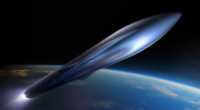3D Printing Thrusts Satellite Toward 2017 Launch

3D printing of the thruster’s combustion chamber and nozzle was done at Fraunhofer’s Institutes of Laser Technology, in Aachen, Germany, and Machine Tools and Forming Technology, in Augsburg. Photo courtesy Airbus Defence and Space

Last June, ADS hot-fired the world’s first spacecraft thruster with a 3D-printed combustion chamber and nozzle made of platinum-rhodium alloy. Photo courtesy Airbus Defence and Space


Manufacturers that assemble parts for 21st-century spacecraft are well aware that what they’re making is often the first of its kind. What’s more, these companies thrive on the challenge and scrutiny that comes with building unique products. Airbus Defence and Space (ADS), the newest division of the Airbus Group, is one such manufacturer.
Last June, ADS hot-fired the world’s first spacecraft thruster with a 3D-printed combustion chamber and nozzle made of platinum-rhodium alloy. The 10-newton hydrazine thruster is a small rocket engine (eight to 10 centimeters long) that controls a navigation satellite’s altitude, trajectory and orbit.
Steffen Beyer, project manager for ADS, says the thruster successfully passed the series of firings, which lasted more than one hour and totaled 618 ignitions. The firings included a single burn of 32 minutes, during which a maximum throat temperature of 1,253 C was attained.
“It demonstrates that performance comparable to a conventional thruster can be obtained through 3D printing,” says Beyer. “We produce 150 to 200 thrusters in this class per year for different customers. 3D printing offers considerable future savings and should allow shorter production cycles and a more flexible production flow, such as manufacturing on demand.”
Testing of the prototype thruster took place at ADS’s facility in Lampoldshausen, Germany, for a European Space Agency (ESA) project called Additive Manufacturing Technologies for Advanced Satellite Thrust Chamber. This project is part of ESA’s Advanced Research in Telecommunications Systems program. Launch of the first satellite with 3D-printed thruster components is planned for sometime in 2017.
Heraeus Holding GmbH supplied the platinum-rhodium alloy powder, which was then atomized by Nanoval GmbH & Co. KG. 3D printing was done at Fraunhofer’s Institutes of Laser Technology, in Aachen, Germany, and Machine Tools and Forming Technology, in Augsburg.
“Platinum-rhodium was chosen for this first phase [because it’s] the most mature platinum alloy for additive manufacturing,” explains Beyer. “In the next phase, we will attempt to print using platinum-iridium, a new alloy (also from Hereaus) that has performance advantages. This alloy [is not] easily manufactured by traditional techniques like casting and forging, so printing is the only way it can be harnessed for space use.”
Based in Hanau, Germany, Heraeus has contributed to different space projects over the past several decades. In 1969, the Apollo 11 mission landed a laser reflector on the moon. This reflector contains 100 triple prisms made of Suprasil, a specialty quartz glass developed by Heraeus. To this day, the reflector determines the exact distance between Earth and the moon. By directing a high-intensity infrared laser beam at the reflector, scientists can measure the return transit time of the light.
More recently, the company provided two special gold and platinum alloy cubes to the ESA for its participation in the Laser Interferometer Space Antenna project. The cubes allow researchers to measure minute changes in distance caused by gravitational waves, which Albert Einstein posited to be “wrinkles” in the space-time continuum in his general theory of relativity.
In addition, space agencies from around the world have used iridium catalysts from Heraeus for many years. These catalysts break down hydrazine used in rocket fuel to power engines for probes and satellites.
For more information on 3D printing metal powders, call 562-921-7464 or visit www.heraeus.com.
Looking for a reprint of this article?
From high-res PDFs to custom plaques, order your copy today!








